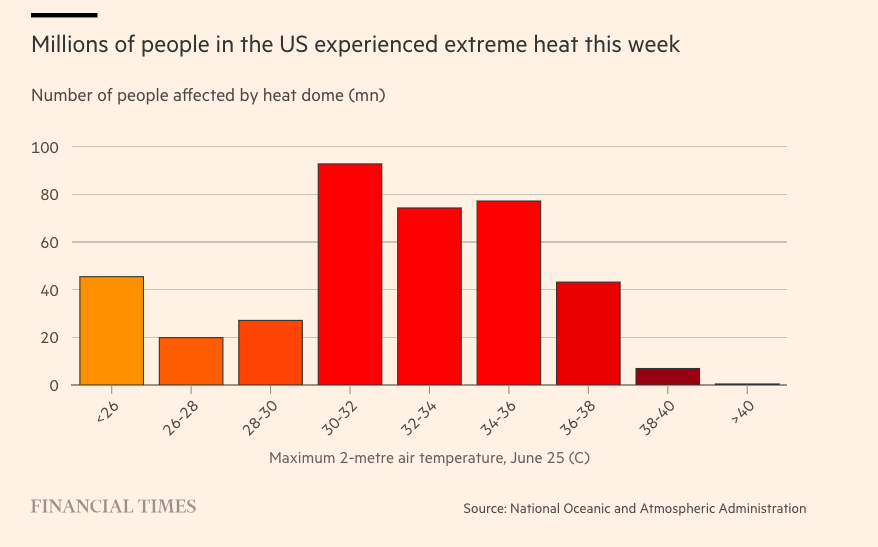Temperatures reach dangerous highs as ‘heat domes’ hit Europe and US
Published: June 26, 2025
This article was originally published in Financial Times
Scientists say the atmospheric phenomena have almost tripled in strength and duration since 1950s
Scientists said “heat domes” and related atmospheric events behind extreme weather around the world had almost tripled in strength and duration since the 1950s, as tens of millions of people sweltered in “dangerous heat” in parts of the US and Europe.
Countries including Greece, Spain and France have faced unusual June heatwaves due to a heat dome — a phenomenon that occurs when a high-pressure system traps heat — having formed over part of Europe.
The inland southern Spanish city of Seville was forecast to reach 42C on Sunday.
The UK Met Office said higher temperatures were likely to build into the early part of this week, particularly in south-east England and east Wales, where peak temperatures of as much as 35C on Monday have been forecast.
“This, in part, will be influenced by a heatwave developing across western Europe,” said Mike Silverstone, deputy chief meteorologist at the Met Office.
The UK Health Security Agency has issued amber and yellow heat-health alerts for much of England from Friday until Monday.
The Met Office said on Sunday that overnight temperatures would remain high, with some locations “not dropping below 20C in what is called a tropical night”.
These warm nights meant that there was little recovery from the hot days, and in south-east of England the heatwave may continue into Tuesday, it added.

A large wildfire south of Athens on Thursday closed the coastal road leading to the tourist attraction of the Temple of Poseidon at Sounion, where temperatures approached 40C.
Temperatures passed 40C in parts of the US in the past week as a heat dome took hold across eastern and central states. In Manhattan, temperatures hit 99F (37C) and John F Kennedy airport reached 102F (38.9C).

At the same time, persistent low pressure systems saw China’s south-west hit by flooding, causing deaths and the evacuation of thousands, with warnings from the China Meteorological Administration issued about extreme rainfall in parts of Guizhou, Yunnan and Sichuan. Pakistan and north India have also reported fatalities from flash flooding.
“Dual heat domes” in both Europe and North America were likely to “become more common as we continue to heat the planet”, said Michael Mann, professor at the Department of Earth and Environmental Science at the University of Pennsylvania.
Research by Mann and colleagues, published in the journal Proceedings of the National Academy of Sciences, found that the amplification of waves in the jet stream — the fast-moving band of air encircling the planet — had led to a dramatic increase in atmospheric events, driving heatwaves, wildfires and floods.
The phenomenon, known as quasi-resonant amplification, causes low- and high-pressure weather systems to linger over a region for longer periods.
The study of the jet stream behaviour calculated the number of quasi-resonant amplification episodes within each year.
Using seven decades of data, a trend emerged in the annual count of events during the summer in the boreal region, or the northern climatic zone south of the Arctic, where the jet stream encircles the globe.
This corresponded to roughly a tripling from approximately one event per year to about three when calculated over the past 70 years.
The present “dual heat domes show that this was part of a very large-scale pattern”, which was linked to a “very wiggly jet stream where the ‘wiggles’ stay in place for days on end”, Mann said.

Existing climate models were “not entirely capturing the phenomenon and how it is impacted by human-caused warming”, he added.
Amanda Maycock, University of Leeds professor of climate dynamics, said the weather considered “typical” for summer was a concept of the past, as changes in weather patterns and the jet stream contributed to regular extremes of temperature and rainfall.
While the reasons for the change in atmospheric patterns were not fully understood, it was certain the continued rise in greenhouse gases would intensify heatwaves, she added.
“We now expect that temperature records will be regularly broken, not by a small amount but often by large margins,” Maycock said. “We must remind ourselves this is not normal. Climate change is standing before our eyes.”